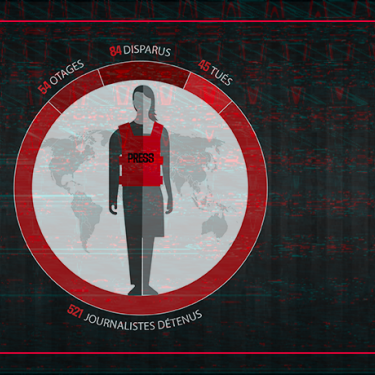Killed because they are journalists – counted with care

Reporters Without Borders (RSF) keeps a constant count of the number of journalists all over the world who are killed, detained, held hostage or subjected to enforced disappearance because they are journalists. We use a rigorous methodology that serves a cause – protecting journalists, combatting impunity for crimes of violence against them, and supporting them in their work.
How did RSF calculate that, as of 1 December, at least 13 journalists had been killed in the course of their work in Gaza since the start of the war between Israel and Hamas, and that 56 journalists had been killed in Gaza overall? What do these figures say?
Since 1995, the annual round-up of violence and abuses against journalists has been based on data compiled by RSF after gathering detailed information around the world allowing us to affirm with certainty or a great deal of confidence that the death, detention, abduction or disappearance of each journalist was a direct result of their journalistic work, that is to say, that they were working at the moment that they were the victim of this abuse, or they were targeted because they were a journalist.
Nowhere in the world does RSF count the deaths of journalists who were killed for reasons or in circumstances unrelated to their work or when the circumstances remain unknown.
To produce these figures, we gather all possible information about the circumstances of the death of each journalist, using our network of correspondents in 160 countries. Cases in which we obtain sufficient indications or evidence to conclude that reporters were killed (or imprisoned) because they were journalists (in the course of their work or because of it) – in the course of their work or because of it – are incorporated into our press freedom barometer (a monitoring tool) and our annual round-up (published in mid-December).
“The rigour of RSF’s methodology is its strength. This is not an amalgam of figures collected from third parties. It is a count carried out with precision and rigour by our team, based on verification of the facts and an essential criteria – a decision based on a sufficiency of indications or evidence. We think the burden of proof rests with us. We would not be serious if we were maximalist in assuming that every journalist killed was killed in the course of their work. Those trying to start a battle of numbers are fighting the wrong battle.
In the case of Gaza, RSF has been able to establish with a sufficient degree of certainty that, as of 1 December, at least 13 journalists had been killed because they were journalists. We continue to investigate tirelessly to identify the circumstances of the death of every reporter. Was this journalist’s home targeted? Were they working at the time? Were they targeted because of their work? As can be imagined, this research is complex and takes time.
As regards Gaza, RSF systematically reports the total number of journalists killed. It was 56 in Gaza as of 1 December, according to our information.
This statistical work supports our public and institutional advocacy aimed at combatting impunity for crimes of violence against journalists. Since 7 October, our advocacy work has included filing a complaint with the International Criminal Court for war crimes against journalists in Gaza, RSF’s third complaint since 2018.
